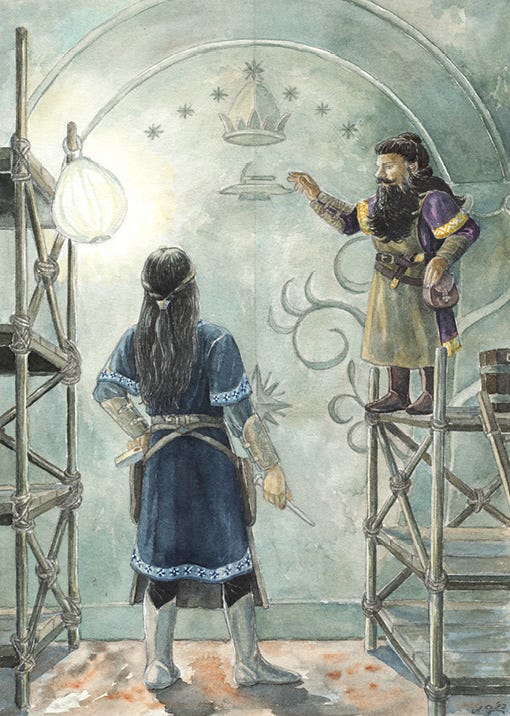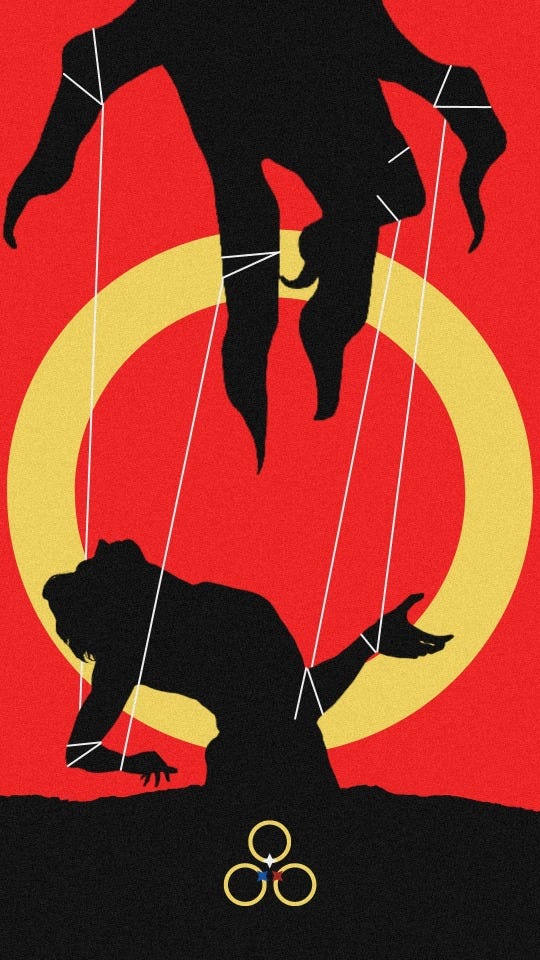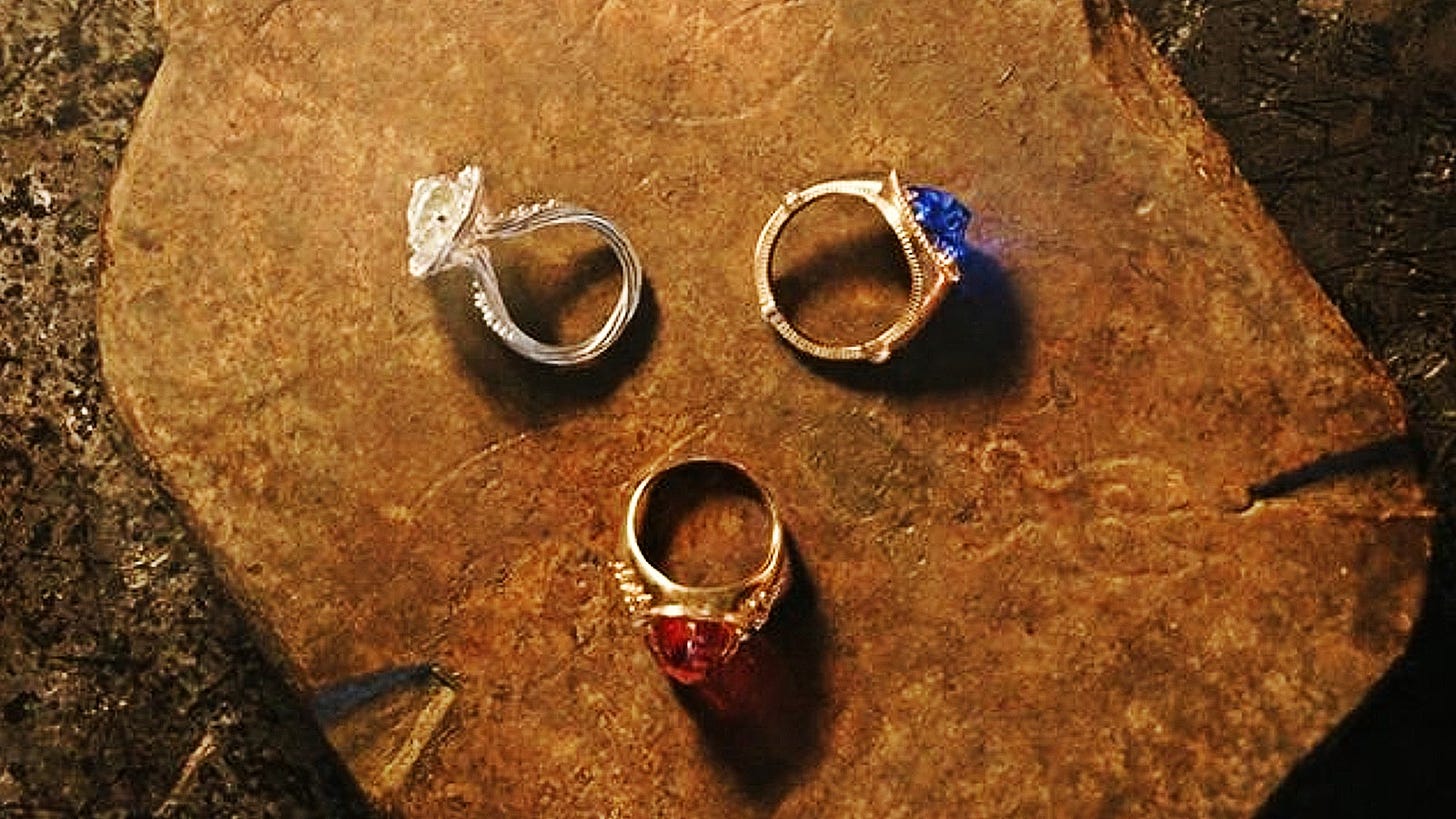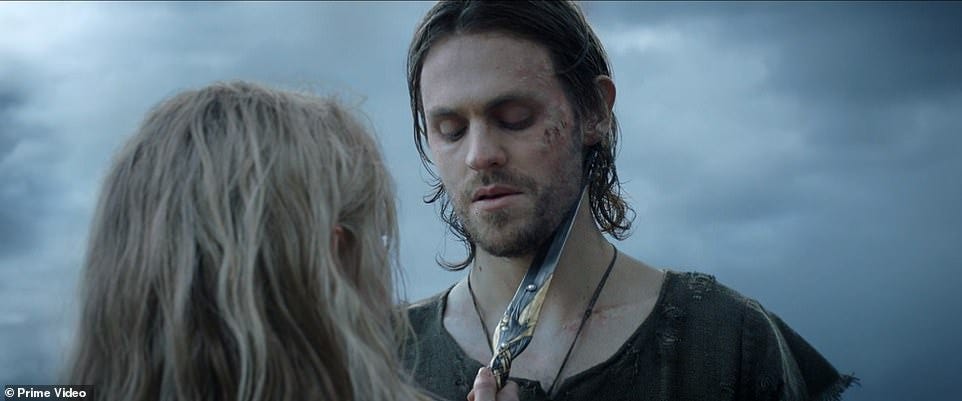Rings of Power's Celebrimbor Problem: S1 EDITION
I'm just so tired, I don't know that I can do this for another four seasons.
Back before S1 of Rings of Power came out, I wrote a blog post concerned about how Rings of Power was going to handle Celebrimbor and Sauron’s relationship. I proposed three possible options: leave as is, lean in, or lean out. Realistically, I expected them to either leave as is or lean out, but I truly could not have predicted how far they would lean out. So, finally, after many months of having extreme ROP Anxiety, I’ve decided to write down everything I think about what they have done.
Two things are important to note right at the start:
My critique is not with Charlie Vickers, the actor playing Halbrand/Sauron, nor with Charles Edwards playing Celebrimbor. I think they are excellent actors doing their best with what they have been given. I have full faith that Charlie’s Annatar will be compelling. The acting is, in this case, irrelevant. And, to that point,
I am not here to speculate on what’s going to happen in S2. I would much rather just wait and see what they do, rather than tie myself into knots trying to figure out what I can just wait for. I’ll touch on S2 possibilities in the end, but this discussion is strictly about S1 as it stands.
So, let’s begin.
What do I mean by leaning out?
In my previous post, I explained that one of the options for how to proceed with the source material (which, if left as is, would read as queer-coded on screen to a modern audience, regardless of authorial intent) would be to essentially pull a no-homo and try to correct as much as possible. I expected some amount of this, but I did not expect them to lean so far out that they broke the frame—and that is, in my opinion, exactly what they did. But how did they do that? By giving most of Celebrimbor’s story-beats to other characters and cutting the amount of time Sauron and Celebrimbor share on-screen to the bare minimum to the detriment of the internal consistency of the story.
The first thing they did to de-queer Celebrimbor and Sauron as much as possible was to shift the majority of Celebrimbor’s plot points onto other characters.
One such example of giving Celebrimbor’s friendship with the dwarves to Elrond. I am not here to criticize Elrond and Durin’s plotline. I think Elrond and Durin’s plotline is the strongest one in the entire show and I would like to keep it forever. That does not change that the story should have been Celebrimbor’s. Celebrimbor and the dwarf Narvi’s friendship literally created one of the single most iconic images in Middle-earth, the Doors of Durin. Yet, Narvi is nowhere to be seen and Celebrimbor is depicted as a bit wary of befriending the dwarves. Will we see Narvi in S2? Possible, but no sign of that yet. But how is this a de-queering, you may be asking? It isn’t, on its own, but it begs the question of why they minimized Celebrimbor’s screen time when combined with all the other factors.
The most important of these plot points is the seduction of Celebrimbor by Sauron, which has been all but moved from Celebrimbor onto Galadriel. We could go around in circles for days about whether or not this seduction is meant to be a sexual seduction or a metaphorical seduction (anyone who has heard me speak on this point at conferences knows that I speak from experience at how roundabout these arguments can be), but that argument is a distraction. Regardless of authorial intent, if left as is, the seduction of Celebrimbor by a stunningly beautiful elf-like, demigod-like male-presenting figure would read as inherently queer to a modern audience in a visual medium. By transferring the bulk of Sauron’s seductive powers onto Galadriel instead, they have released the pressure on a pressure valve while also maintaining Sauron’s in-character behaviour pattern. A brilliant move, really, if de-queering is your goal. Now, I have no problem with Haladriel as a ship, I think it’s very compelling and the actors do a great job with it. The issue is not that Galadriel is seduced as well, but that Celebrimbor has been removed from this almost entirely (as of Season 1). As I have said before and will say again, more is more.
Except, there is one major problem with placing the weight of the seduction on Galadriel in terms of internal consistency, and it’s a pretty big one. With the finale of S1, Galadriel is now responsible for bringing Sauron into Eregion and holds the weight of the blame for what is to come. This is not only a direct contraction to the lore, but it is a big contradiction to the lore. Tolkien worked until the end of his life trying to figure out the kind of character he wanted Galadriel to be, and wrote and re-wrote her to strip her of as much blame as possible (See: “the History of Galadriel and Celeborn” in Unfinished Tales). Now, that does not mean I agree with Tolkien’s later considerations, and I think Galadriel as very much part of the failures of the Noldor is important, but not this failure. While it’s not clear that Galadriel could outright see through Sauron’s disguise (where Gil-Galad and Elrond are cited as not falling for it), we can assume that she was at the very least suspicious, as Annatar “endeavoured therefore to placate her, bearing her scorn with outward patience and courtesy”.
This failure is significantly Celebrimbor’s failure, not Galadriel’s failure. This failure, on Celebrimbor’s part, is his fate as a Fëanorian under the doom of Mandos. Yes, Celebrimbor will still make the Rings under Annatar’s guidance in S2 from the looks of the trailer (but I am choosing not to speculate on exactly how they’re going to manage to contort themselves out of their own knot at this point), but the weight of that has been greatly reduced and significantly shifted onto a character who should have no moral responsibility for this, who now bears this burden.
This brings us to the next thing that they did to release the pressure valve on the inherent queerness of the story they were meant to be telling: change the order in which the rings were made to minimize the amount of time Sauron and Celebrimbor spend together.
This is something that is completely wild to me and is the primary reason why my faith in this show has dropped so spectacularly, from a general eight out of ten to a five-or-less out of ten. The show’s title is Rings of Power. Yet, they shoved the creation of the elven rings of power into the last 30 minutes of the first season. If it were the other rings that were made first in these last 30 minutes, I could understand that. It’s the big cliffhanger, the rings are now being made, queue the music. But that is not what they did. What they did is alter the structure of the story itself, the story that is foundational to The Lord of the Rings.
In Tolkien’s story, the order in which the rings are made is significant. The other rings must be made first because they are made with Sauron’s help. It is only after Celebrimbor realizes what Sauron has done that he makes the three elven rings in secret, without Sauron’s help. It is these three elven rings made in secret that cause Sauron to siege Eregion in the first place and kick off the war. It is these three elven rings being made in secret which allows Lothlorien and Rivendell to thrive in the Third Age and not be corrupted by Sauron, because he had nothing to do with their making and thus cannot find them or control them (1). Yet, in Rings of Power, Sauron was directly involved in their making, and they are made first. This change has a direct impact on the structure of The Lord of the Rings.
If you know me, you know I love adaptation. I’m generally very accepting of changes to canon or changes to the lore for the purpose of an adaptation. I am very very rarely a lore snob. But this one makes absolutely no sense. It seems wildly irrational to me that one of the ONLY stories that Tolkien actually handed down to us from the second age has been massacred so badly. The only reason I can come up with (aside from perhaps just sheer stupidity in terms of storytelling) is to minimize Sauron and Celebrimbor’s screen time. The most important of the rings are done, the rest can be an afterthought. Now, I am aware that we are going to get Celebrimbor and Sauron making the other rings in S2, but we don’t know how long those scenes are going to be, and we don’t know how they are going to attempt to untangle themselves from the net of their own making. I am not here to speculate, only to report on what we have now, and it’s a mess.
This, of course, brings me to the 10-15 minutes of screentime together that we did get, and how they effectively de-queered that as well.
(Yes, if you really squint you can get some crumbs, but I am not going to applaud them for their crumbs. I’m happy for you if you can be sustained by crumbs, but it simply is not good enough when the source material is as rich as it is.)
One thing that is important to acknowledge is that the show was hampered by recasting Celebrimbor mid-way through. While this could be a reason for why they had a total of about 10-15 minutes of screentime together in the first season of a show titled after the objects of their mutual creation (the titular Rings of Power), that does not explain everything else that they did, which was either planned out well before shooting (see: Elrond and Durin, Galadriel and Halbrand, the rings being made out of order) or on which this would have had no impact (see: costume and makeup, which I’m about to talk about now).
Speaking of costume and makeup, let’s talk about the visual rhetoric of masculinity and cleanliness! Before I can point out exactly what my major problem is with how Halbrand is presented within the 10-15 minutes of screen time, I need to point out the heavy de-queering effect of Halbrand’s styling throughout the entire show.
In 20th and 21st-century Western media, the idea of men being beautiful is intimately entwined with ideas of effeminacy, queerness, and emasculation. I am not going to waste time dragging out all my sources, this is a blog post, not an academic paper, and you the reader know this to be true from experience. Tolkien, very significantly, did not ascribe to this view, as he frequently describes his male characters (Frodo, Aragorn, male elves) as beautiful, as often if not more often than his female characters. Yet when he describes Aragorn or Frodo’s beauty, it is very different from Annatar/Sauron’s beauty. This is exemplified by Frodo’s line in Fellowship of the Ring, that a servant of the enemy would look fairer and feel fouler. Aragorn may be handsome but, as Strider, he looks rugged, messy and dangerous. It is this rugged, messy appearance that puts Frodo at ease because he (rightly) assumes that a servant of the enemy would want to appear pleasant to look upon, and would appear inviting and unthreatening.
So then, Halbrand’s styling from the beginning is contrary to Tolkien’s own idea of the methodology of good versus evil. Yes, Sauron is a shapeshifter and he can present himself however he likes to best achieve a goal. Not quite sure what the goal in looking rugged and messy was, but fine. Still, he is made rugged and stereotypically “manly”, and for what purpose? If it’s to attract Galadriel, that’s a bit silly as she’s an elf who would be used to elvish aesthetics. In my opinion, he was styled to be attractive-as-ideal to a very standard, traditional heterosexual audience, both male and female. He’s ruggedly handsome in a way that would appeal to some straight women and is a safe ideal of masculine handsomeness to straight men, without bordering on the homoerotic.
We get to Eregion and he’s ridden into with a serious injury, looking absolutely wrecked. In the fateful scene in which Sauron first meets Celebrimbor, in which Sauron is meant to seduce Celebrimbor and speaks of bringing gifts, Halbrand looks like a half-dead rat. He is a far cry from the beautiful, ethereal emissary of the Valar, and he is not even granted the dignity of being presented as a noble King of the Southlands. He has been styled to look as physically unattractive as a handsome actor can be. Frankly, he looks like he’s about to pass out or soil himself.
These details are not accidents. Twice is a coincidence, three times is a pattern, and we are well into pattern territory. It is again no accident that they styled Celebrimbor the way that they did. Again, I have no issues with Charles Edwards. In fact, I think he’s a very handsome man, and if they wanted to style him as a handsome older man, they very well could have done that (I would direct you to his styling in The Terror, as a very handsome Victorian ship’s surgeon). Instead, they dressed him almost exclusively in an unflattering velvet mumu (though bless his forge outfit, it truly was a relief to see), pottering about like an elderly gentleman with trouble retaining his memory. That he has frequently been cited on the internet as reminding people of Ian Holms’ Bilbo is, again, not an accident. These are stylistic choices that were made with the purpose, and that purpose seems to be to lean as far back from the inherent homoeroticism of Sauron and Celebrimbor’s plot line as humanly possible without cutting Celebrimbor from the story entirely.
Which, I suppose, brings us to S2. What do we actually know is going to happen? We know Sauron is showing up as Annatar. We know that Celebrimbor is going to make his mistakes. We know that Eregion will be sieged. These are the only things we know for certain. We don’t know for certain if this will take five episodes or 30 minutes. We don’t know how much of the length of the series was in the trailer. We simply do not know enough to make assumptions as to what will happen next. What we do know is that the showrunners tied themselves into a rhetorical knot with how they ended S1. At the end of S1, Halbrand/Sauron leaves Eregion, having helped make the Three and ONLY the Three. Galadriel tells Celebrimbor to his face that Halbrand/Sauron is gone, and that none of them are ever to treat with him again. Celebrimbor has seen his face and worked with him, and the Annatar form we have seen has the same face.
Now, there are a ton of variables here that I am not accounting for here. There are plenty of ways they can try to get themselves out of this knot. That does not change that they have tied themselves into this knot in the first place, and untying a knot believably without having to completely retcon what you just did is very tricky. I simply do not have enough faith in the writers of this show to believe they are capable of such contortion effectively. But we’ll see. I just find it extremely bizarre and extremely suspect that a show called Rings of Power has reduced the entire first half of the storyline they are based on to about twenty minutes in one episode when that was an entire subterfuge plotline that could have been a very compelling whole-season narrative with many moving parts. Instead, they rushed it, and why?
I can’t even say, in this case, that the writing was wholly bad because it wasn’t. What it was was intentional. If it was just bad, I think I would have been less suspicious.
If you’re interested in seeing my commentary as it happened in real time my tweet threads are here and here.
And, just for the record, I do have one speculative theory that I think is worth putting on the table: Eärien was invented as a way to release the pressure valve of Sauron and Ar-Pharazôn’s homoeroticism. If you would like to hear me speak about that relationship, you can find it here. Mark my words: Sauron is going to seduce Eärien, she will build the temple to Morgoth and then be sacrificed. He may even seduce her into manipulating Kemen, which is how he gets to Pharazôn. This will take the pressure off of Sauron and Ar-Pharazôn substantially.
(1) Okay, I needed to footnote this statement. With the help of Cameron Bourquein, I combed through UT to try and figure out the logistics of how this works, and I personally believe the unfinished notes in UT are actually contradictory in places to the internal logic of what Tolkien actually came up with as a “final” product. What substantially matters here is that, for the purposes of The Lord of the Rings, the Three not being touched by Sauron is WHY they are able to remain hidden while still in use. The Nine and the Seven, while he had to go looking for them, were touched by him and so could be corrupted and then found. Not so with the Three (at least, for as long as he did not have the One on him, then all bets were off). Much like how if the One was used, the Nazgul would know in which direction Frodo might be, theoretically Sauron would be able to always see the Nine and would at least be able to homing-beacon-locate the Seven eventually. Though anything to do with the Seven is really where it gets complicated and convoluted, see: the logistical faff in UT.











OK, I am totally torn between the complete and utter love I have for your brilliant analysis of de-queering (I HAD to subscribe to be able to comment, and to go read some of the past posts!) which is accompanied by a demand for more, more, MORE! -- and an equally strong desire to look over my bifocals in my professorial way and encourage you to get some rest, and find some FUN fandom stuff, and that you don't have to do this . . .so, um, yeah. Torn.
I'm going to post a link to your piece, and to another fascinating one by Jokien with Tolkien on Jackson's LOTR because you're both doing the kind of triangulating of reader response, close textual analysis, and comparative analysis (book and adaptation) that is pure catnip for me. And then I'll probably babble on about my ideas in the another post or two, thus making an, erm, trilogy!